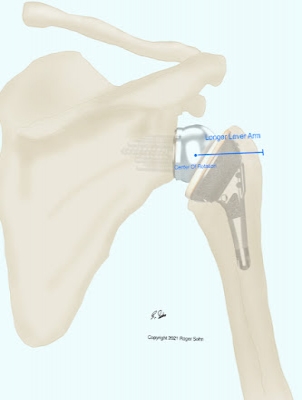What is a reverse shoulder replacement?
When the shoulder wears out, we sometimes have to place an artificial joint called a reverse total shoulder. It involves placing a new "ball" where the socket used to be. It's called a reverse shoulder because we put the socket where the ball previously sat.
What does a reverse shoulder replacement look like?
This is an example of what the new shoulder looks like when we place a reverse shoulder replacement.

Why would you reverse the mechanics of the shoulder?
Sometimes we need to do this because of severe wearing out of the socket bone. Other times, we need to use this implant due to a chronic rotator cuff tear. Traditional or "anatomic" shoulder replacements don't work well in these scenarios since the implants get unstable and/or loosen from the bone. The reverse total shoulder replacement allows us to put a deep dish ball and socket liner in place. This creates a much more stable arrangement than the native shoulder, which is quite prone to instability.
In addition to creating a stable socket, the reverse total shoulder replacement medializes the shoulder's center of rotation. This gives the deltoid a longer lever arm. In cases where the rotator cuff is torn, the reverse total shoulder replacement restores the shoulder's strength by optimizing the mechanics of the remaining muscles.



